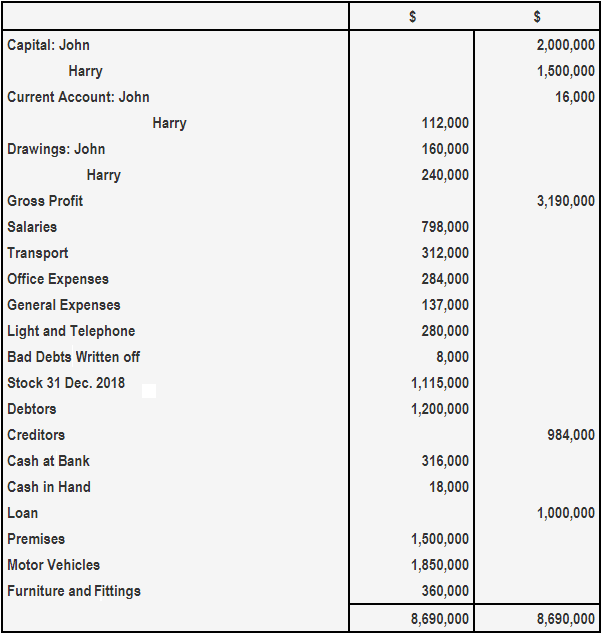
If an asset has lost its usefulness, the loss should be recognised and the final disposition should not be waited for. If it is fairly definite and if the amount of the loss can be measured reasonably well, it should be recorded as soon as it is ascertainable. The realisation principle is more strictly followed in recognition of gains and losses. Gains are not generally recognised until an exchange or sale has taken place.
- Operating expenses cover administrative, general, and selling expenses not directly tied to production.
- For instance, a company that delivers a product or service to its customer records the revenue on its P&L statement, even though it hasn’t yet received payment.
- Say that substantial refunds were expected as companies took advantage of outstanding tax credits previously issued as a way of retaining jobs in the state during the recession.
- The market position of a company, which shapes the industry dynamics, is tremendously swayed by its financial health.
Accrual Method
Losses are recorded in the income statement, which details the revenues and expenses over a specific period. A loss occurs when expenses exceed revenues, resulting in a negative net income. This outcome affects the equity section of the balance sheet since retained earnings are reduced by the amount of the loss. Unlike gains and losses, revenues and expenses are not opposite financial results of the same activities.
Does a capital loss benefit from depreciation?
The balance sheet is typically presented as of the last day of the company’s fiscal year. Investors use the balance sheet to understand the financial strength of the company, comparing the amount and quality of its assets against its liabilities. The cash method, which is also called the cash accounting method, is only used when cash goes in and out of the business.
Types of P&L Statements
Yes, even if a company has a large volume of sales, it can still end up losing money if the cost of goods or other expenses related to those sales (e.g., marketing) are too high. Other factors like taxes, interest expenses, depreciation and amortization, and one-time charges like a lawsuit can also take a company from a profit to a net loss. Because revenues and expenses are matched during a set time, a net loss is an topic no 458 educator expense deduction example of the matching principle, which is an integral part of the accrual accounting method. Expenses related to income earned during a set time are included in (or “matched to”) that period regardless of when the expenses are paid. Losses refer to the decreases or reductions in the value or amount of an asset, or the incurrence of a liability, that result in a negative impact on a company’s financial performance.
Net Income (Net Profit)

They are essentially accounting techniques that are often employed as part of corporate tax planning to balance out periods of profitability with periods of loss. Losses due to write-offs are a regular part of doing business and a key part of managing a company’s financial health. It’s just as important to know when to recognize a loss as it is to recognize income. The total profit of a company after all expenses, taxes, and costs have been subtracted from total revenue. An incurred expense becomes a paid expense once the business has paid the cost it owed the supplier of the goods or services.
Since the loss is outside of the main activity of a business, it is reported as a nonoperating or other loss. The term losses is also used to report the writedown of asset amounts to amounts less than cost. It is also used to refer to several periods of net losses caused by expenses exceeding revenues. A profit and loss statement, also called an income statement or P&L statement, is a financial document that summarized the revenues, costs, and expenses incurred by a company during a specified period. Purposely selling goods for less than market value or trying other tax-reduction strategies might get you into trouble if the practices are obvious tax dodges. You will want to enter all items on income statement (also known as a profit-and-loss statement) correctly.
The quadratic loss function is also used in linear-quadratic optimal control problems. In these problems, even in the absence of uncertainty, it may not be possible to achieve the desired values of all target variables. Often loss is expressed as a quadratic form in the deviations of the variables of interest from their desired values; this approach is tractable because it results in linear first-order conditions.
A profit and loss (P&L) statement, also known as an income statement, is a financial statement that summarizes the revenues, costs, expenses, and profits/losses of a company during a specified period. These records provide information about a company’s ability to generate revenues, manage costs, and make profits. When a company reports a gain, such as the sale of an asset, it may be recorded in its total revenue for a given period. In this way, total revenue includes operating revenue, which are sales from primary business activities, as well as non-operating activities.
An example of a capital loss is when an investment listed in the books at $48,000 is sold for $45,000; this leads to a capital loss of $3,000. Capital losses are losses made on the sale of a fixed asset or resulting from raising money for the business. Gains and losses are treated differently for tax purposes, depending on if they are short-term (usually occurring in 12 months or less) or long-term (taking place over more than one year). In addition, gains can typically be offset by corresponding losses for tax purposes. In the case of sale of an asset or loss by fire or other catastrophe, the timing of the event is fairly definite.
